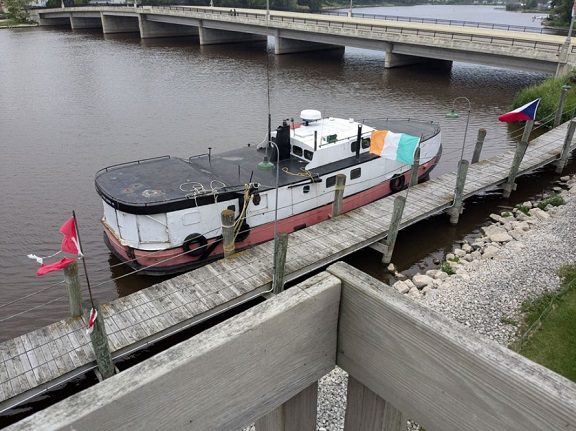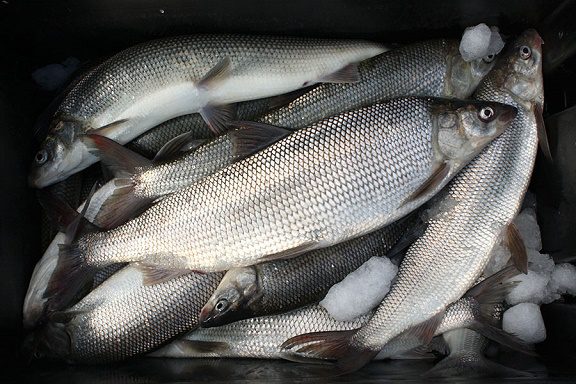ONCE THERE WERE MANY, NOW THERE IS ONE: THE LAST COMMERCIAL FISHING BOAT OUT OF TWO RIVERS AND ITS CONNECTION TO A HOLLYWOOD MOVIE STAR
By James Heinz
In a previous article on the Rogers Street Fishing Village Museum in Two Rivers, Wis., I covered the history of the commercial fishing industry in Two Rivers.

A few blocks south of the Rogers Street museum, at 1810 E Street, is a small store called “Susie Q Fish Company.” The small store sells different types of fish from around the world, as most seafood stores do. But the Susie Q Fish Company sells a type of fish that no other seafood store carries.
It is the Lake Michigan whitefish that the store’s owner catches himself in his own boat.


Owner Paul LeClair’s family’s history in the Two Rivers fishing industry goes back many years. Up the street at the Rogers Street museum, the LeClair fish shed is a reconstruction of their family fish shed from years ago. And Peter LeClair owns the SUSIE Q fishing boat tied to the dock at the museum that was featured in my article. The boat itself, as well as the fish store, are named for his father’s sister.
Paul and his cousin Peter LeClair still operate their own fishing boat from a dock located behind the fish store. Appropriately enough, the boat is called PETER PAUL. It is a classic Great Lakes fish tug, a design unique in the world. Wikipedia tells us how the design evolved:
“The fish tug evolved from small, open, motorized boats which had replaced sail-powered fishing boats on the Great Lakes by the early 20th century. Fishermen soon began experimenting with enclosed cabins and net lifters, making the boats safer and more convenient…Most of these earlier coverings left the forward deck and stern uncovered, but by the 1930s it became common to add a pilothouse amidship or near the stern, and to continue the cabin covering to the bow in what was known as a “sprayhood.” Steel-hulled boats began to replace wooden-hulls in the late 1950s.”
PETER PAUL is unique for several reasons.
She is the last commercial fishing boat operating out of Two Rivers. In 1957-1958 there were 35 commercial fishing boats operating out of Two Rivers.
Indeed, she is one of the last commercial fishing boats on this side of Lake Michigan. Paul LeClair told me that there only 48 licenses issued by the Wisconsin Department of Natural Resources for commercial fishing boats. However, some commercial fishermen hold multiple licenses, so there are only 35 full time and about 10 part time commercial fishermen in Wisconsin waters.
PETER PAUL is also the southernmost commercial fishing boat in Wisconsin. All the other boats are located farther north, most of them in Door County.


Finally, PETER PAUL is the only trawler boat on Lake Michigan.
Almost all Great Lakes fishing boats are pound net boats, trap net boats, or gill net boats.
A pound net is a series of nets anchored to the bottom and protruding above the surface that deflect fish and guide them into a trap, called a “pound”, where they mill about until harvested with a dip net.
A trap net is like a pound net but consists of a single box like net with multiple openings that fish swim into and then find they cannot get out until the trap net is pulled up and the fish harvested.
A gill net is a net that hangs down vertically in the water column from floats at the surface. The mesh in the net is sized large enough that fish can stick their heads through it, but not their bodies. When the fish tries to back out of the mesh, their gills get caught in the net. The fish remain trapped until the net is pulled up and the fish harvested.

Trawler fishing involves the fishing boat towing behind it the wide mouth of a cone or funnel shaped net that narrows to a closed end. The net is towed through the water column scooping up fish as it goes until the net is closed and brought aboard the ship and fish are harvested.
Paul’s father Peter LeClair (not to be confused with Paul’s current cousin Peter) began fishing in 1950. They carried on the family tradition of farming and fishing begun by their grandfather.

Fishing was a family affair. Paul’s mother mended the nets, kept the books, and raised the kids while their father was out in the Lake all year, including in winter when he broke ice with the boat and often came back with the boat completely covered with ice.
Father Peter incorporated in 1965 and began trawling in the 1960s and 1970s. He trawled for alewives, whose population had exploded when the invasive species numbers could not be controlled by the declining lake trout population.
Alewives were so prolific that mounds of them washed up on Milwaukee beaches and had to be buried with earthmoving equipment on the beach. The smell was so bad that downtown office buildings sent their workers home.
Humans do not eat alewives but cats and other pets eat them. There were no bag limits on alewives, and they were sold to pet food makers for one to one and half cents a pound. Paul recalled bringing in semi-truck trailer loads of alewives.
The LeClair family also helped the cause of underwater archeology by assisting early shipwreck hunters like Kent Bellrichard and John Steele. The LeClairs remembered the places where they snagged or lost nets, places that often turned out to be shipwrecks.
Paul told me about one famous wreck hunter, who shall remain nameless, who would show up with a quarter barrel of beer at the dock when the LeClairs returned from fishing. The wreck hunter would share the barrel of beer with the fishermen in an effort to persuade them to tell him where they lost their nets, although Paul remembered that the wreck hunter actually drank most of the beer himself.
After that, Paul LeClair and his family lived through what Wikipedia refers to as: “Beginning in the 1970s, new regulations began to greatly restrict gill-net fishing, making the fish tug all but obsolete in the United States of America.”
Once salmon, who do nothing but swim and eat alewives, were introduced, the alewife population declined. And so did the types and amounts of other fish that commercial fishermen were allowed to catch. Nowadays, Paul and Peter are limited to a quota of 200,000 pounds a year by the DNR.

Today they fish solely for whitefish from December to July. Whitefish like 45 degree water and follow the thermocline, and Paul and Peter follow the fish. In the summer the whitefish like to get off the bottom and come to the surface to feed on flies.
A typical fishing day starts at 4:30 am and ends around 1 pm. The boat makes 4 or 5 drags, each taking an hour, catching 400-500 pounds of whitefish per drag. A total catch of 2,000 to 3,000 pounds in a day is a good catch. The fish are cleaned on the boat during each drag.
Although as Paul says, in the old days “The river was crowded with boats”, those days are long gone, for a variety of reasons. Many young people do not want to be commercial fishermen. Paul’s 17 year old son would like to continue the tradition, but help is hard to find. The boat requires a minimum crew of 2 or three. His son may end up running a sport fishing charter boat.
Second, the price of a new boat is out of reach for most. Paul LeClair bought the PETER AND PAUL in 1974 for $25,000. He estimates a new boat would cost $1 million today.
Another problem is damage done to their nets by objects they snag on the bottom. Trees that wash into the Lake and sink to the bottom are one major problem. But on the bottom of the Lake off Cleveland. Wis., there is one particularly destructive object that causes much more damage to their nets.
Military drones.
Although military drones are much in the news now, they are nothing new. According to a 2017 Sheboygan Press article, during World War II the U.S. Army established an anti-aircraft gunner training facility called Camp Haven on the shores of Lake Michigan at what is now the site of the world-famous Whistling Straits golf course.

The Army used small, radio-controlled drone aircraft to tow long cloth banners used as targets for the gunners. The drones were equipped with parachutes that would bring them down if they were hit. Some of the drones fell into Lake Michigan where they remain today on the bottom.
Wikipedia describes the drones, designated OQ-2, as being about 9 feet long with a wingspan of 12 feet. They were painted red and launched by a catapult.
These drones are so destructive to fishing nets that Paul LeClair refers to them as “a pain in the ass.” So, who built these pains in Paul’s ass?
Marilyn Monroe
In June 1945, a U.S. Army photographer named David Conover visited the Radioplane Corporation plant in Burbank, California. Radioplane built the drones. He met an 18 year old woman then named Norma Jeane Dougherty, who worked on the production line at the plant, spray painting the drone parachutes 10 hours a day for $20 a week.

Conover took her photo and told her she should be a model. She took his advice and quite the company and became world famous after Hollywood changed her name to Marilyn Monroe. That is why a photo of Norma Jeane Dougherty holding the propeller of one of the drones that now litter the bottom of Lake Michigan appears in every biography of Marilyn Monroe.
It should be noted that the drones themselves were invented by a former silent film star named Reginald Denny and photographer Conover’s commanding officer at the First Motion Picture Unit was Lieutenant Ronald Reagan, then actor and future President.
In later years Norma Jean/Marilyn would say that building the drones was the hardest work she ever did. But then again, she was never a commercial fisherman out of Two Rivers, Wisconsin, and never had to recover one of her own drones from a commercial fishing net.
Michigan state underwater archeologist Wayne Lusardi once said about the bottom of Lake Michigan: “There are a lot of interesting things out there.” Some of those interesting things were built by Hollywood’s famous.
____________________________________
James Heinz is the Wisconsin Marine Historical Society’s acquisitions director. He became interested in maritime history as a kid watching Jacques Cousteau’s adventures on TV. He was a Great Lakes wreck diver until three episodes of the bends forced him to retire from diving. He was a University of Wisconsin – Milwaukee police officer for thirty years. He regularly flies either a Cessna 152 or 172.
Photos by James Heinz unless noted otherwise:
Peter LeClair and cousin Paul LeClair with their fish boat
Susie Q Fish Company of Two Rivers, Wis.
LeClair Fish Shed of Two Rivers, Wis.
SUSIE Q. fish boat
PETER PAUL fish trawler
PETER PAUL fish trawler stern view
Paul LeClair with trawler winch
Paul’s father Peter LeClair’s boat during the winter
Whitefish catch
Drone on the launching catapult courtesy of Wikipedia
Norma Jeane Dougherty aka Marilyn Monroe in Yank Army Weekly courtesy of Wikipedia

